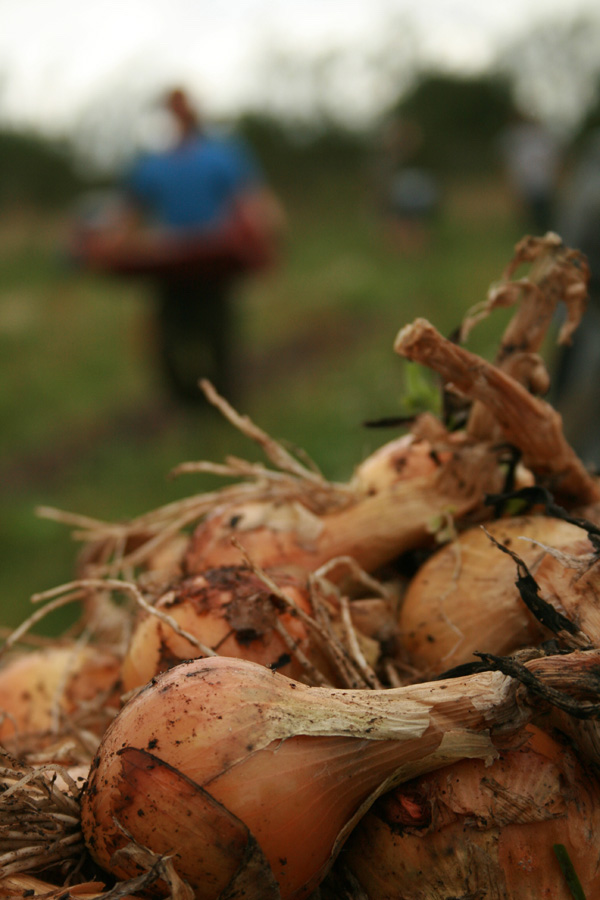
This straightforward dish from the late Jocasta Innes’ classic The Pauper’s Cookbook is recommended by one of Camel CSA‘s members. The recipe became a favourite when she was a student. Serve with the sprouting broccoli or kale in this week’s veg boxes.
Serves 4
Preparation time: 20 minutes
Cooking time: 2 hours
Ingredients
50g butter
50g plain flour
600ml milk
sea salt and ground black pepper
grated nutmeg (optional)
4 large onions, peeled and very thinly sliced
4 large potatoes, peeled and very thinly sliced
125-150g bacon, rind removed, cut into strips
Method
Preheat the oven to 200°C/Gas 6). Make a white sauce by melting the butter on a low heat in a small pan, stir in the flour and gradually whisk in the milk. Bring to the boil stirring all the while, once smooth and thick, reduce the heat to a very low simmer, add the seasoning and nutmeg and leave it ticking over while you prepare the rest of the ingredients.
Grease a casserole dish and build up in layers of onion, potatoes and bacon bits, ending with potatoes. Pour the white sauce over the top and jiggle well to distribute the sauce evenly. Cover and bake for 1 hour at 200°C/Gas 6), uncover and reduce to 180°C/Gas 4) and cook for 1 final hour. Serve with winter vegetables such as broccoli, sprouts, kale or cabbage.
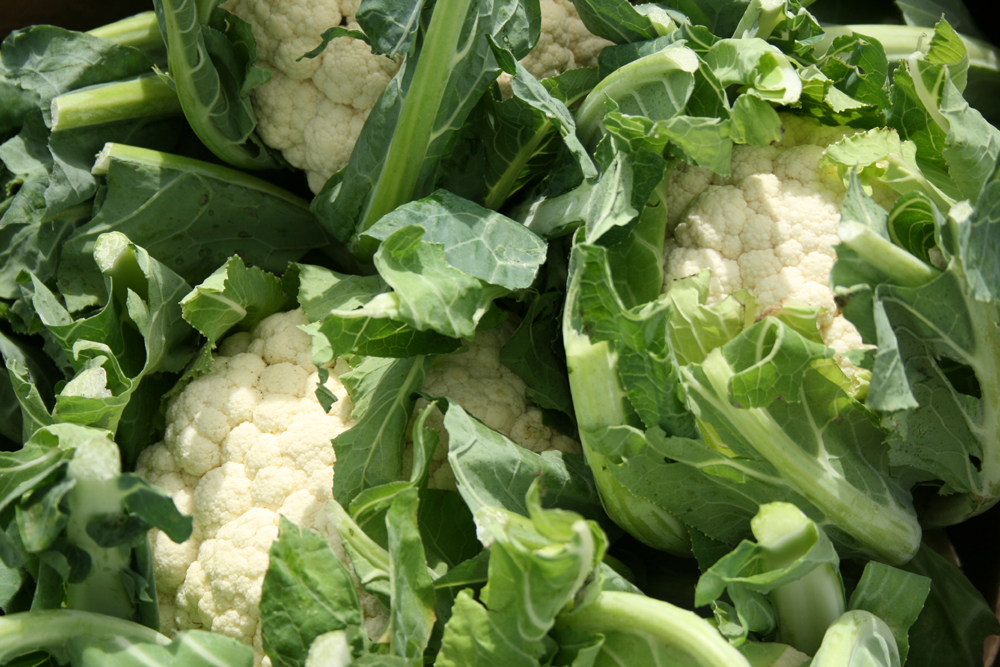
We had this tasty curry recently, the lentils and coconut milk give a nice creamy sauce. Use the green coriander in Camel CSA’s veg boxes this week.
Serves 4
Preparation time: 20 minutes
Cooking time: 40 minutes
Ingredients
3 tbsp vegetable oil
1 onion, finely chopped
1 fat garlic clove, finely chopped
25g fresh root ginger, grated
2 tsp ground coriander
2 tsp ground cumin
1/2 tsp ground turmeric
75g red split lentils
150ml vegetable stock
1 cauliflower, cut into small florets
1 large carrot, peeled and sliced
400 ml can coconut milk
75g green beans
3 tbsp chopped fresh coriander
1 tbsp lemon juice
salt and freshly ground black pepper
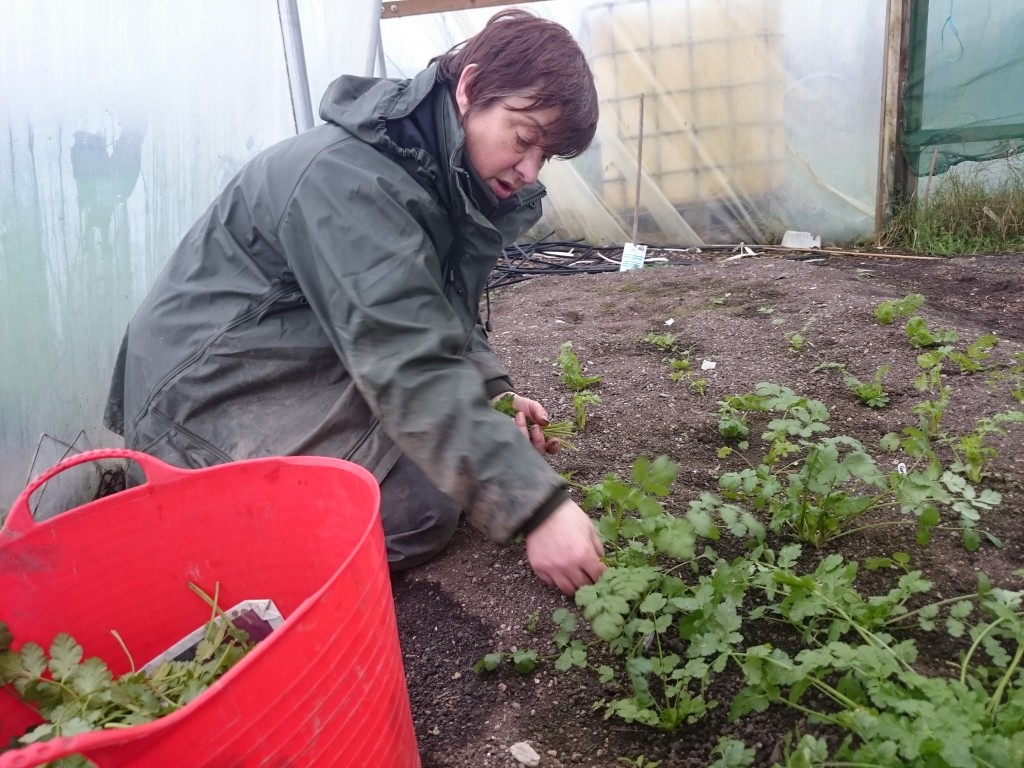
Method
Heat 2 tbsp of the oil in a large saucepan and gently cook the onion for 10 minutes, stirring frequently, until soft and translucent. Add the garlic, ginger,ground coriander, cumin and turmeric and cook for 2 minutes, stirring all the time. Stir in the lentils, then pour in the stock. Bring to the boil, then reduce the heat, cover and gently simmer for 10 minutes.
Meanwhile, heat the remaining 1 tbsp of oil in a frying pan and fry the cauliflower for 2-3 minutes until lightly browned. Add to the lentil mixture with the carrots and coconut milk. Bring the curry back to a gentle simmer and cook for a further 10 minutes. Stir in the beans and cook until all the vegetables are tender.
Stir in the chopped coriander and lemon juice, then season to taste. Serve with rice, warm naan or chapatis.
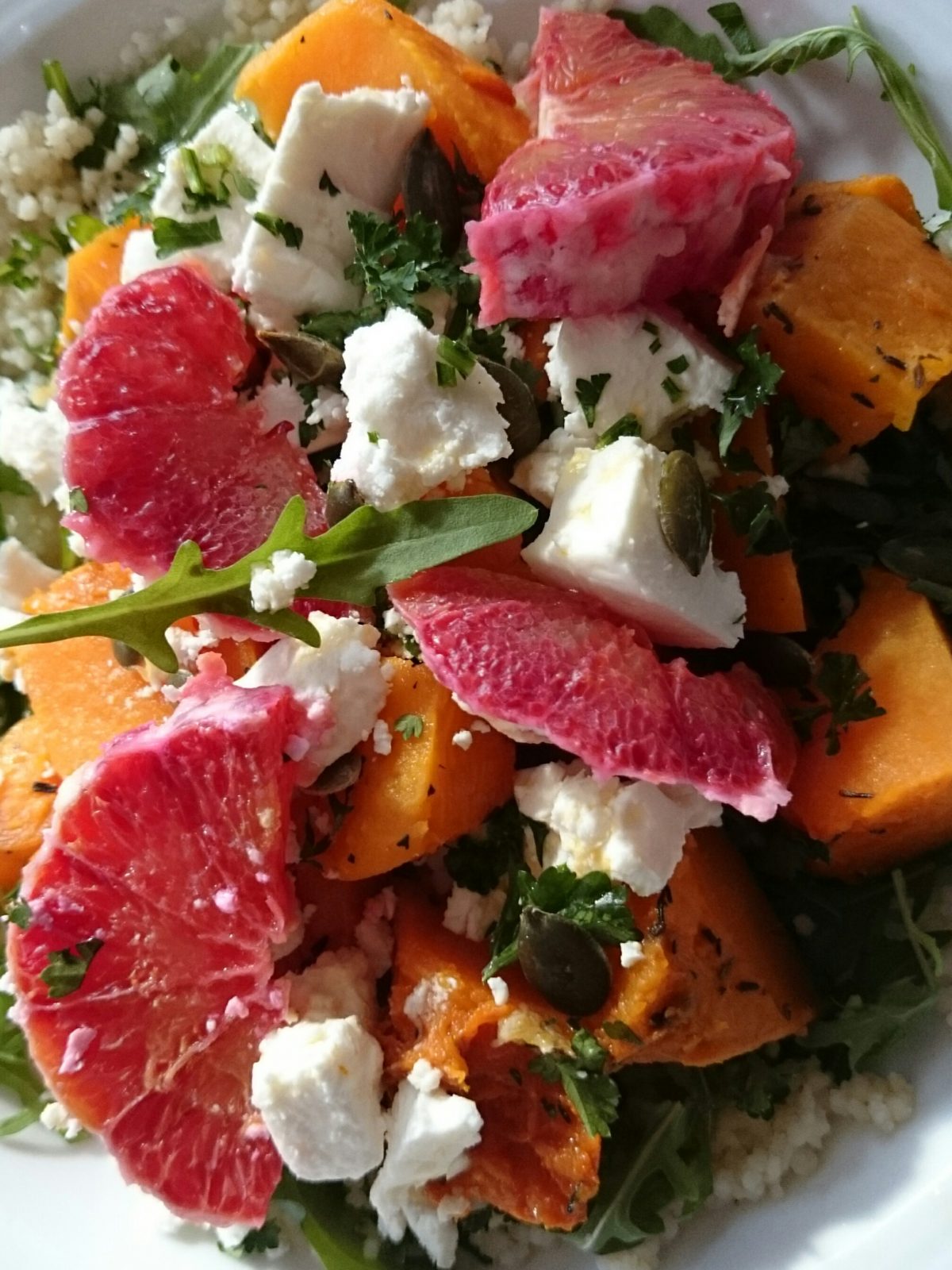
I discovered this salad in a Cook with M&S promo leaflet I picked up in store. It was the only seasonal dish I could find in it!
The best squash to use is Crown Prince, which we have in Camel CSA’s veg boxes this week, but any full-flavoured variety will do.
If you can’t get blood oranges, which are in season at this time of year, use other decent ones instead. I’ve also adapted the recipe to include pumpkin or pomegranate seeds, oriental salad leaves or rocket, and parsley or coriander. It’s up to you.
Serves 6
Preparation time: 20 minutes
Cooking time: 35-40 minutes
Ingredients
800g full-flavoured squash (such as Crown Prince) peeled, deseeded and cut into 4cm cubes
3 sprigs thyme
2 cloves garlic, unpeeled
3 tbsp olive oil
200g couscous
5 oranges – ideally blood oranges
75g pomegranate or pumpkin seeds
100g rocket or oriental salad leaves
small handful chopped parsley or coriander
200g feta cheese, crumbled
Method
Heat oven to 180C/160C fan/gas 4. Put squash, thyme and garlic in a roasting tin and season. Drizzle with 1 tbsp olive oil, then roast for 35-45 minutes. Squeeze the garlic from its skin.
Meanwhile put the couscous in a bowl and add 100ml boiling water and set aside for 15 minutes, then fluff with a fork. Peel and slice four of the oranges. Squeeze the juice from the remaining orange, whisk this with the remaining olive oil and season.
Stir the pomegranate or pumpkin seeds, salad leaves and parsley into the couscous, reserving some to scatter over. Divide the mixture among six plates and top with the squash, orange slices, feta, seeds, salad and parsley. Drizzle with the dressing and serve.
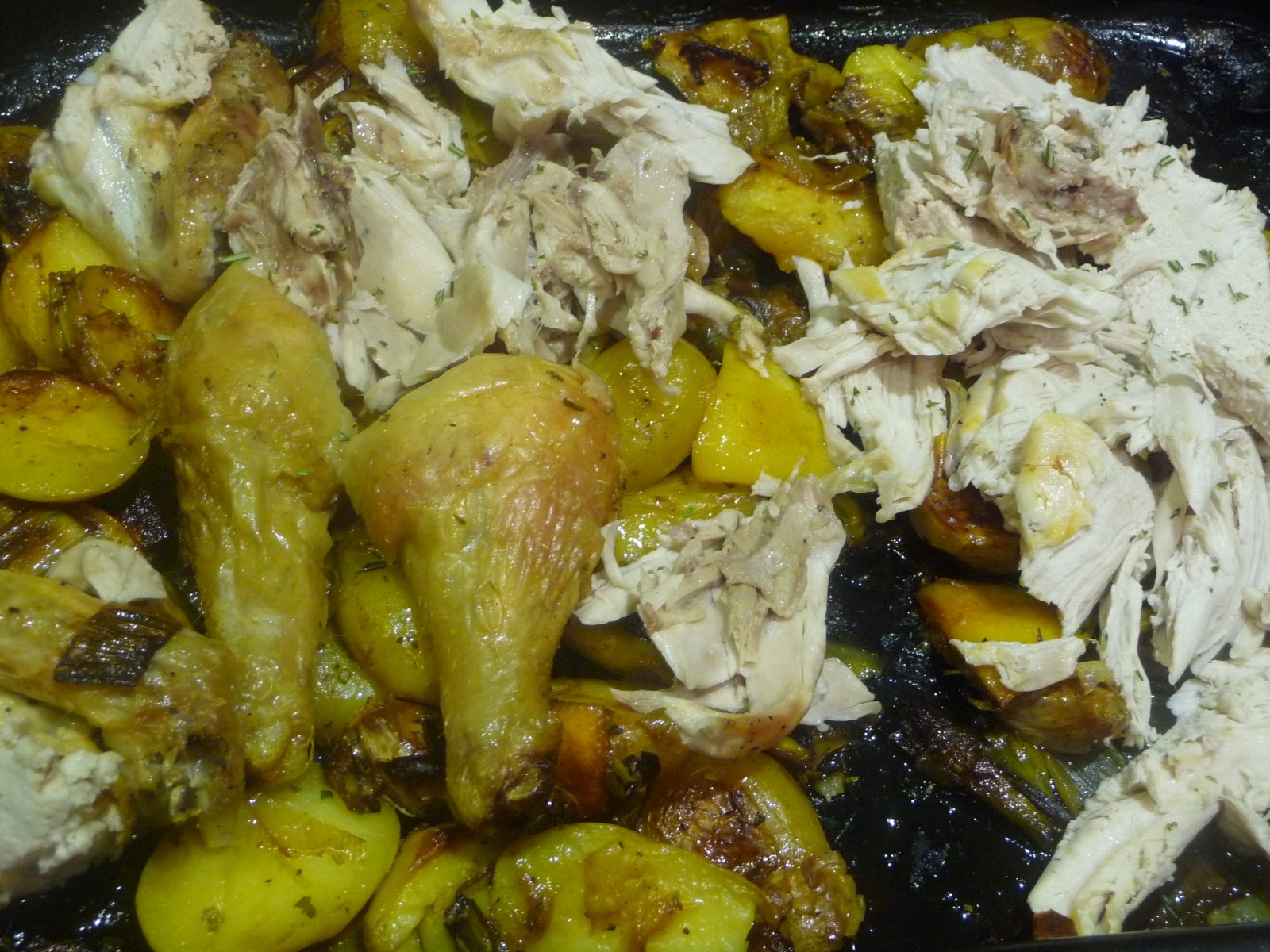
This Nigella Lawson recipe appears in 20 best one-pot recipes in The Observer’s Food Monthly supplement. It’s easy to prepare and tastes delicious.
Serves 6
Preparation time: 20 minutes
Cooking time: 1 hour 20 minutes
Ingredients
4 tbsp olive oil
2 tsp rosemary needles, finely chopped, plus more to serve
1 bulb garlic, separated into unpeeled cloves
2 leeks
1 kg waxy potatoes, washed if necessary, but unpeeled
2 unwaxed lemons
1 medium chicken (approx. 1.4 kg)
sea salt flakes to taste
Method
Preheat the oven to 220°C/Gas mark 7. Get out the biggest roasting tin you have, and pour all but a teaspoon or so of the oil into it. Throw in the chopped rosemary needles and the garlic cloves.
Trim the leeks and cut each in half lengthways, then slice into half-moons and drop these leek curls into the tin too. Cut the potatoes into 1.5 cm slices, then cut each slice into 4, or just halve them if the potatoes are small, and add these to the tin. Quarter the lemons, then cut each quarter in half, take out as many pips as you can and toss the lemon quarters into the pan.
Now schmoosh everything to mix, and then make a space in the middle of the tin for the chicken to sit in. Untruss the chicken, place it in the reserved parking place, pour the tiny bit of the remaining oil on top of it and sprinkle sea salt flakes on top of the chicken only.
Place in the oven for 1 hour and 10 minutes, and if the juices of the chicken run clear when you push the tip of a knife into the joint where the thigh meets the body, remove the chicken to a board to sit, letting the juices from its cavity spill back into the tin as you do so.
Then put the potato mixture back in the oven for 10 minutes until soft and golden. If the chicken needs longer, keep everything in the oven until the chicken is cooked. When it’s ready, and the chicken has rested, carve it or cut into joints as wished. Sprinkle with 1/2 a teaspoon of finely chopped rosemary needles and sea salt flakes to taste.
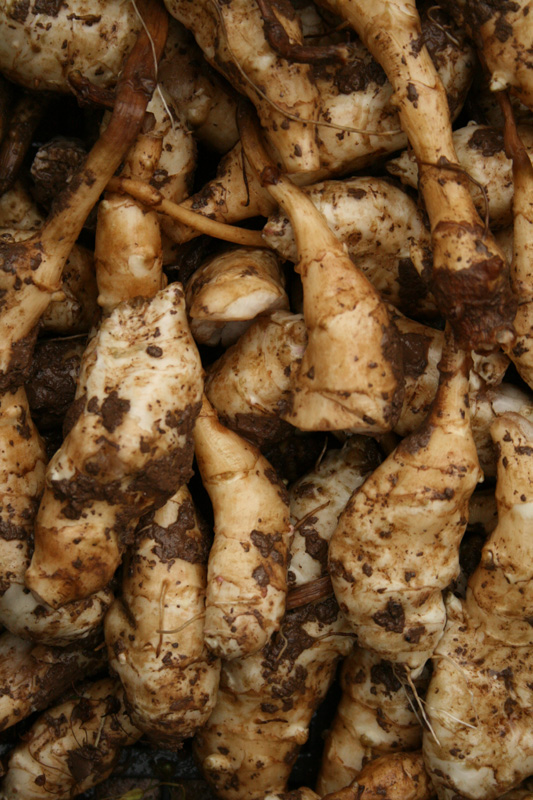
This quick and easy recipe was given to me by Joan, an ex-colleague who was very fond of Jerusalem artichokes. We’ve got plenty in our veg boxes this week thanks to the Hoare family at Restharrow Farm, Trebetherick in north Cornwall. I have no idea where she got the idea from, possibly Elizabeth David.
Serves 2-3
Preparation time: 10 minutes
Cooking time: 20-30 minutes
Ingredients
500 g Jerusalem artichokes
olive oil
2-3 tomatoes, chopped
1 clove garlic, chopped
parsley
chives
Method
Boil the artichokes in salted water, straining them before they are quite cooked. Cut them in halves and sauté them gently in a little olive oil with the tomatoes, garlic, and chives and parsley.
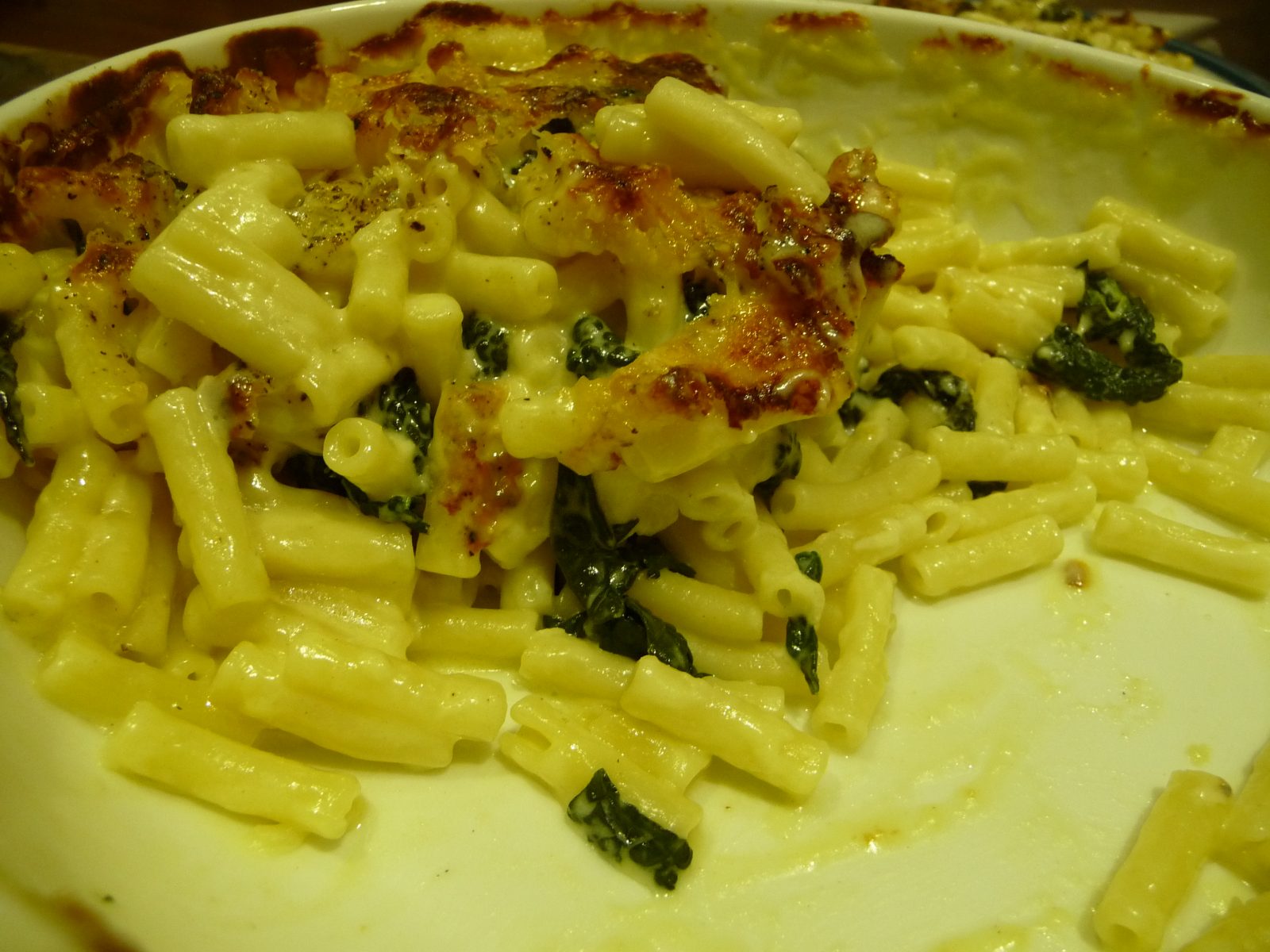
We’ve had this dish twice since Nadiya’s Kitchen arrived in our household at Christmas. I’ve used both curly kale with penne and cavolo nero with macaroni but the biggest recommendation must be from my husband who usually turns his nose up at plain macaroni cheese!
If you don’t have any cream, just use milk. Nadiya, the BBC’s last Great British Bake Off winner, doesn’t pre-cook the kale but I blanche it with the pasta at the end of the pasta cooking time.
Serves 6
Preparation time: 15 minutes
Cooking time: 20 minutes
Ingredients
500g pasta
2 tbsps unsalted butter
3 cloves garlic, crushed
1 tsp English mustard powder
3 tbsps plain flour
250ml whole milk
25 ml single cream
250g mature Cheddar cheese, grated
a large handful of kale leaves, chopped
50g Parmesan cheese, grated
freshly ground black pepper
Method
Preheat the oven to 200°C/Gas mark 6. Bring a large pan of salted water to the boil, and cook the pasta for the recommended time on the packet. Drain and add the oil, stirring it through, this will stop the pasta sticking together.
Melt the butter in a small pan over a medium heat, then add the garlic and mustard powder and cook for 1 minute. Stir in the flour, and cook for another minute, mixing all the time. Add the milk and the cream, and whisk until the sauce is smooth and lump-free. Continue to whisk until the sauce thickens. Take the pan off the heat, add the grated Cheddar cheese and leave it to melt, stirring occasionally.
Now tip the pasta and kale into an oven proof dish, and pour over the sauce. Bake for 20 minutes, until the top is crisp and golden. Sprinkle with the Parmesan and a good grind of black pepper to serve.

Mark, one of our core group members, recommends this soup recipe from Jamie Oliver’s Great Britain. We don’t bother with the cream though,” Mark says, “as it’s rich enough!” Although the recipe uses the butternut variety, any decent squash would do.
Serves 4-6
Preparation time: 15-20 minutes
Cooking time: 60 minutes
Ingredients
1 squash (roughly 1kg), peeled, de-seeded and chopped into 2.5 cm chunks
3 good eating apples, peeled, cored and quartered
1 large onion, roughly chopped
1 or 2 fresh red chillies, halved and de-seeded
4 cloves garlic, unpeeled and bashed
Olive oil
Sea salt and ground pepper
Pinch of coriander seeds
Few sprigs of fresh rosemary, leaves picked and finely chopped
3 heaped tablespoons pumpkin seeds
Pinch of cayenne pepper
800ml cups organic vegetable or chicken stock
150ml single cream
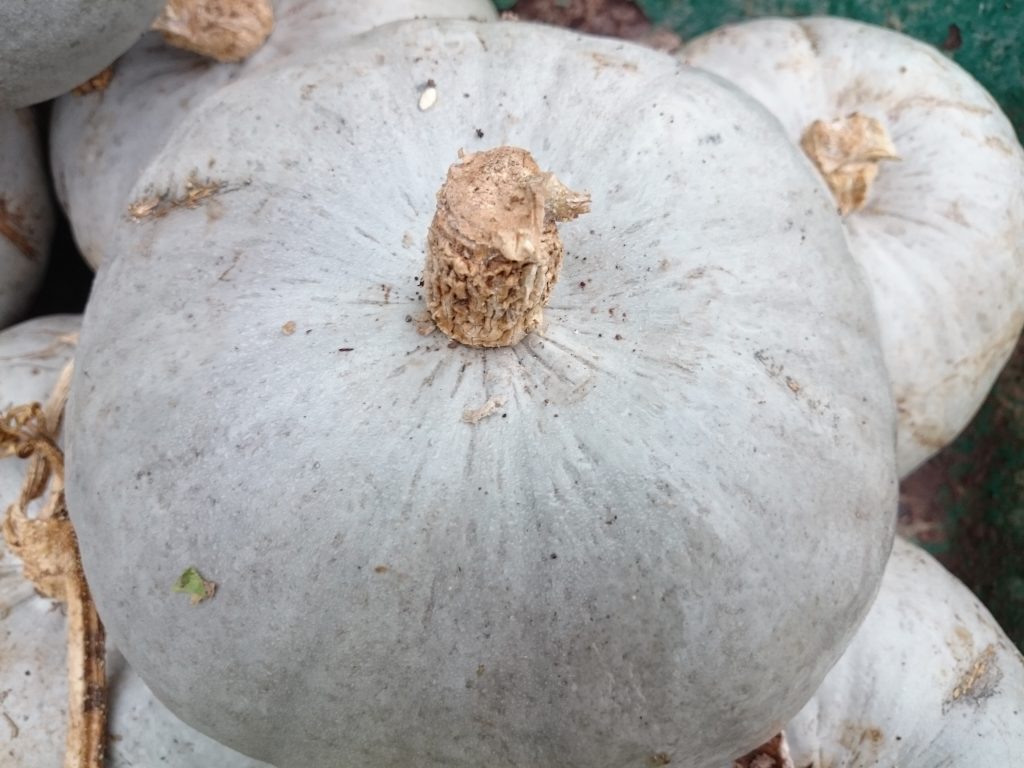
Method
Preheat the oven to 200°C/Gas Mark 6. Put the chunks of squash, apple, onion, chillies and garlic on to a baking sheet and drizzle with a good amount of olive oil. Add a good pinch of salt and pepper and a pinch of coriander seeds and a little chopped rosemary. Toss everything together so all the veg is nicely coated then cook for around 45 minutes or until everything is cooked through, intensely golden and delicious.
Toss the pumpkin seeds with salt, pepper, olive oil and the cayenne. Spread on a baking sheet and roast in the oven for 10-15 minutes then put aside for later.
Put some of the roasted veg into a blender, making sure you squeeze the garlic flesh out of its skin first. Add a swig of stock and gently blitz until smooth and lovely. Put this into a large pan while you blitz the rest. Pour in most of the cream and bring to a simmer over a medium to low heat.
Have a taste, season to perfection. To serve, divide between bowls and add a swirl of cream and a sprinkling of roasted seeds.
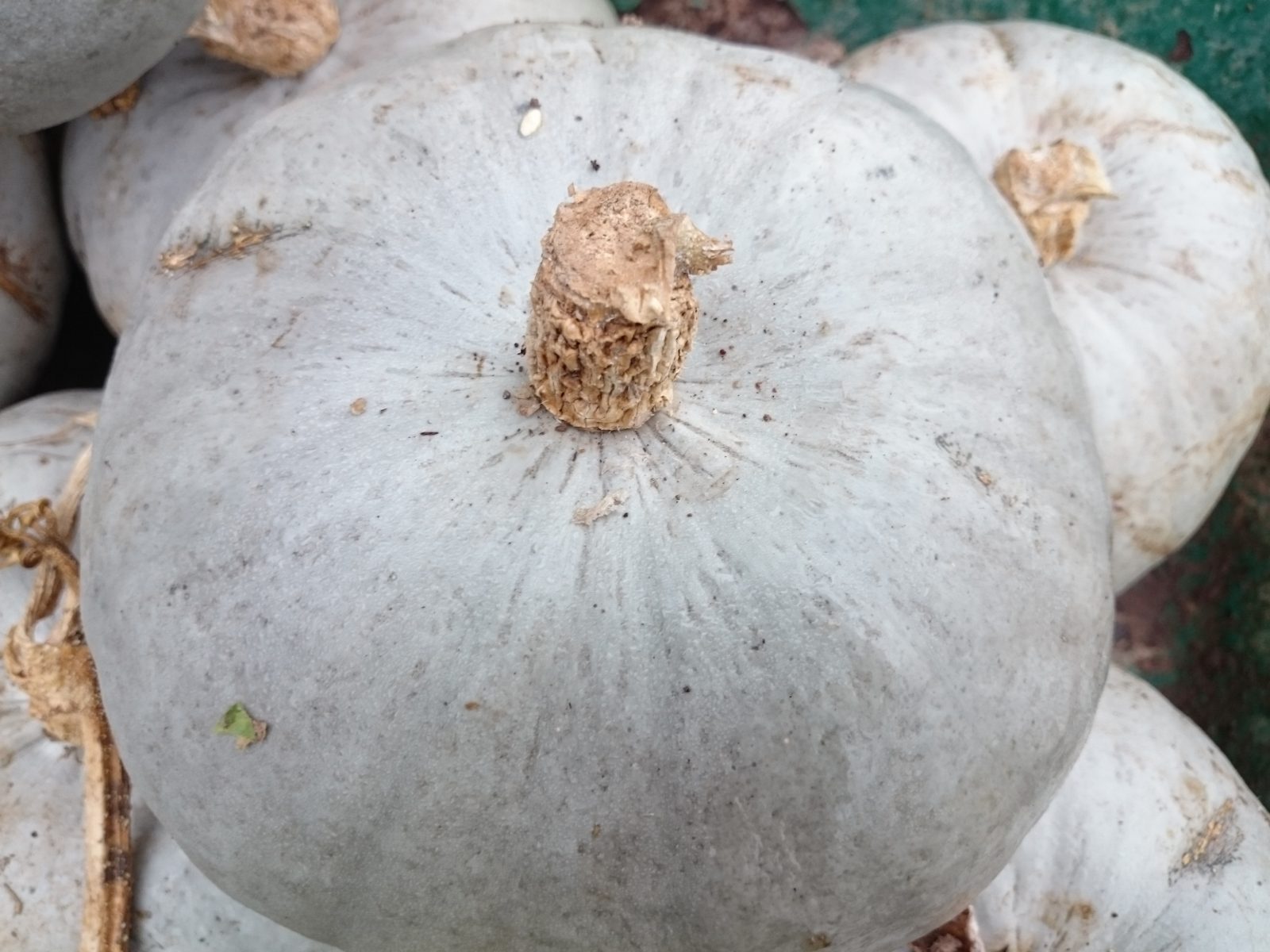
Our professional grower Bridget Gould acquired this simple recipe from a Bangladeshi friend. It’s the perfect antidote to rich festive food!
Serves 4
Preparation time: 15 minutes
Cooking time: 30-40 minutes
Ingredients
1 medium squash, peeled and de-seeded
2 onions, roughly chopped
4 cloves garlic, finely chopped
½ tsp ground coriander
1 tsp ground cumin
1 tsp turmeric
2 cardamom, seeds only
2-3 chillies, deseeded and chopped
juice of ½ small lemon
small bunch fresh coriander, roughly chopped
1 tbsp oil
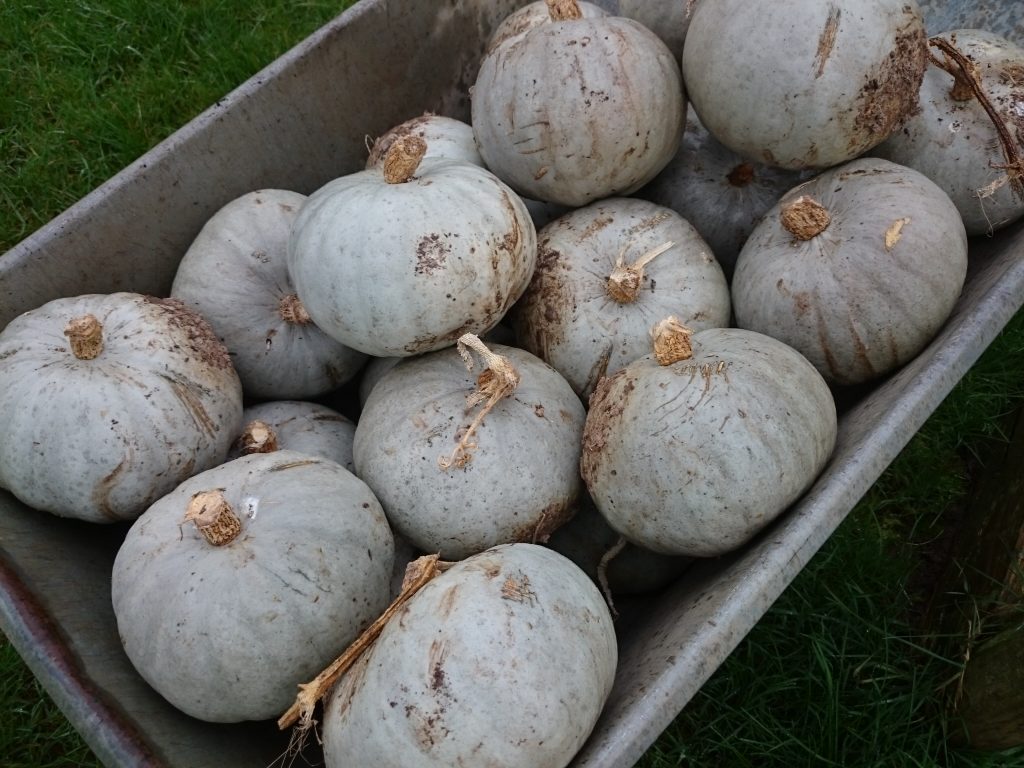
Method
Heat the oil and fry off the spices, taking care not to burn them. Add onions and garlic and fry until soft. If dry add a bit of water.
Next, cut the squash into 2cm chunks and add to the pan, mixing through well. Season with salt and pepper and simmer until the squash is tender. Just before serving add the lemon juice and fresh coriander.

I would have made this parsnip loaf from Nigel Slater in The Guardian if I hadn’t received a request from my son for roast parsnips. Its herb flavourings and seedy texture do sound delicious, so I will try it at some point in the not-too-distant future.
Serves 6
Preparation time: 60 minutes
Cooking time: 45 minutes
Ingredients
parsnips 500g
carrots 250g
apple 1
butter 75g
onions 2, medium
garlic 2 large cloves
parsley 2 heaped tbsp, chopped
rosemary needles 2 tbsp
thyme leaves 1 tbsp
hemp seeds 1 tbsp
pumpkin seeds 1 tbsp
sunflower seeds 1 tbsp
poppy seeds 1 tbsp
eggs 2
butter for greasing the loaf tin
thyme sprigs 8
You will also need a loaf tin measuring about 22cm x 12cm x 8cm, lined with baking parchment.
Peel the parsnips, then cut lengthways into quarters. Grate them finely using the coarse blade of a food processor, slightly thinner than matchsticks, then do the same with the carrot. (I don’t find it necessary to peel the carrots, only to scrub them with a vegetable brush.) Grate the apple, without peeling it, and add to the bowl.
Warm half the butter in a shallow pan, then add the grated root vegetables and apple and let them cook, for 3 or 4 minutes, until they are bright and approaching softness. Tip them into a large mixing bowl. Set the oven at 180C/gas mark 4.
Peel, halve and finely slice the onions. Melt the remaining butter in the shallow pan then cook the onion until it is soft and pale gold. Peel the garlic, crush finely then add to the onion and continue cooking. Tip the onion and garlic into the bowl with the carrots and parsnips. Add the chopped parsley to the mixture then finely chop the rosemary needles and thyme and add them, too. Add the hemp, pumpkin, sunflower and poppy seeds and a generous grinding of salt and pepper.
Break the eggs into a bowl, beat them lightly to combine yolks and whites, then fold into the mixture. Combine the ingredients making sure the seeds, eggs and herbs are evenly distributed.
Line the loaf tin with baking parchment then butter it generously. Scatter a few thyme sprigs over the bottom of the tin. Transfer the mixture into the loaf tin, pressing it firmly into place. Smooth the surface level and cover with buttered parchment. Place the loaf tin on a baking sheet and bake in the preheated oven for about 45 minutes, until lightly firm to the touch.
Remove from the oven and leave to settle for 10 minutes then turn out of the tin and carefully peel away the paper. Cut into slices and serve with the sauce (below) or Cumberland or cranberry sauce.
Stout and onion gravy
A dark and deeply-flavoured accompaniment for this loaf, but also good for spooning over baked vegetables or a slice of pie.
Enough for 6
onions 2, medium
butter 40g
garlic 3 cloves
button mushrooms 250g
olive oil 3 tbsp
thyme sprigs 8
plain flour 1-2 tbsp
vegetable stock 250ml, hot
stout or other dark beer 250ml
fruit jelly, such as redcurrant 4 tbsp
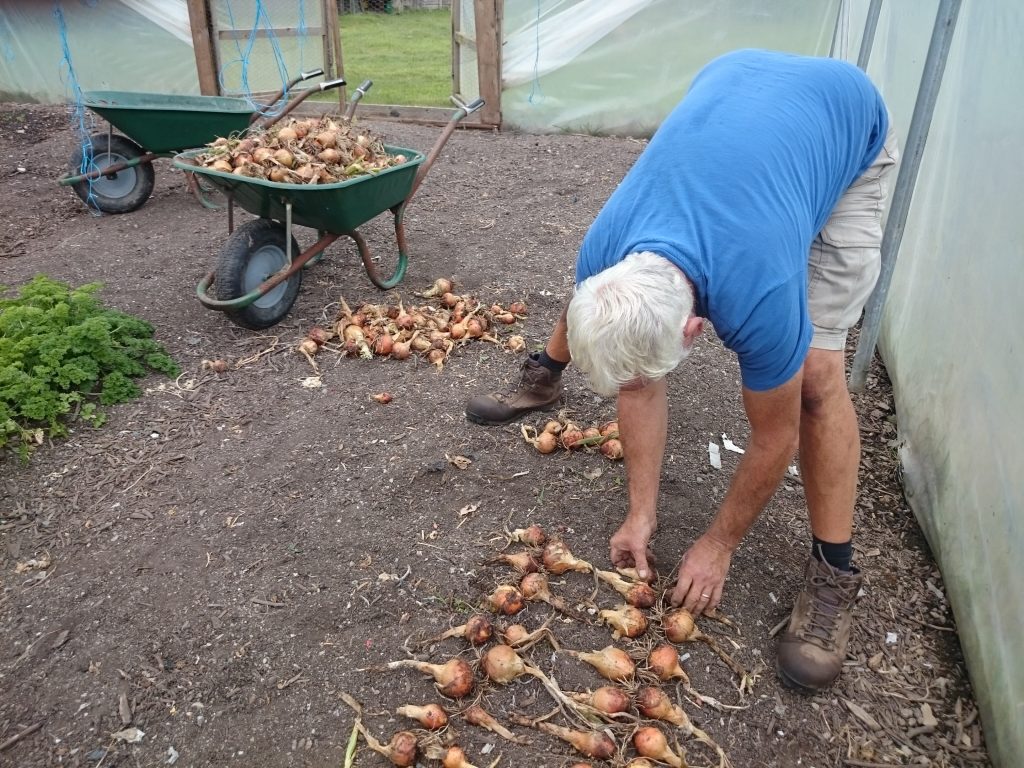
Peel the onions, cut them in half from stem to root, then slice each half into thin segments. Warm the butter in a heavy-based saucepan, add the onion and leave to cook over a medium heat. Peel and thinly slice the garlic, add to the onions and continue cooking for a good 15-20 minutes until the onions are thoroughly soft, golden and sweet.
Slice or quarter the button mushrooms as you wish then add them, together with the oil, to the onions. Pull the thyme leaves from their stalks then stir into the onions and mushrooms. When the mushrooms are soft and nut brown, scatter the flour over the surface, stir and cook for a couple of minutes. Pour in the stock and stout and bring to the boil. While stirring, lower the heat, season with salt and black pepper, then leave to simmer for 15-20 minutes.
Stir in the redcurrant or other fruit jelly, taste for sweetness, adding more if you wish. You are after a nicely-balanced gravy – savoury and sweet with a deep, wintry character.
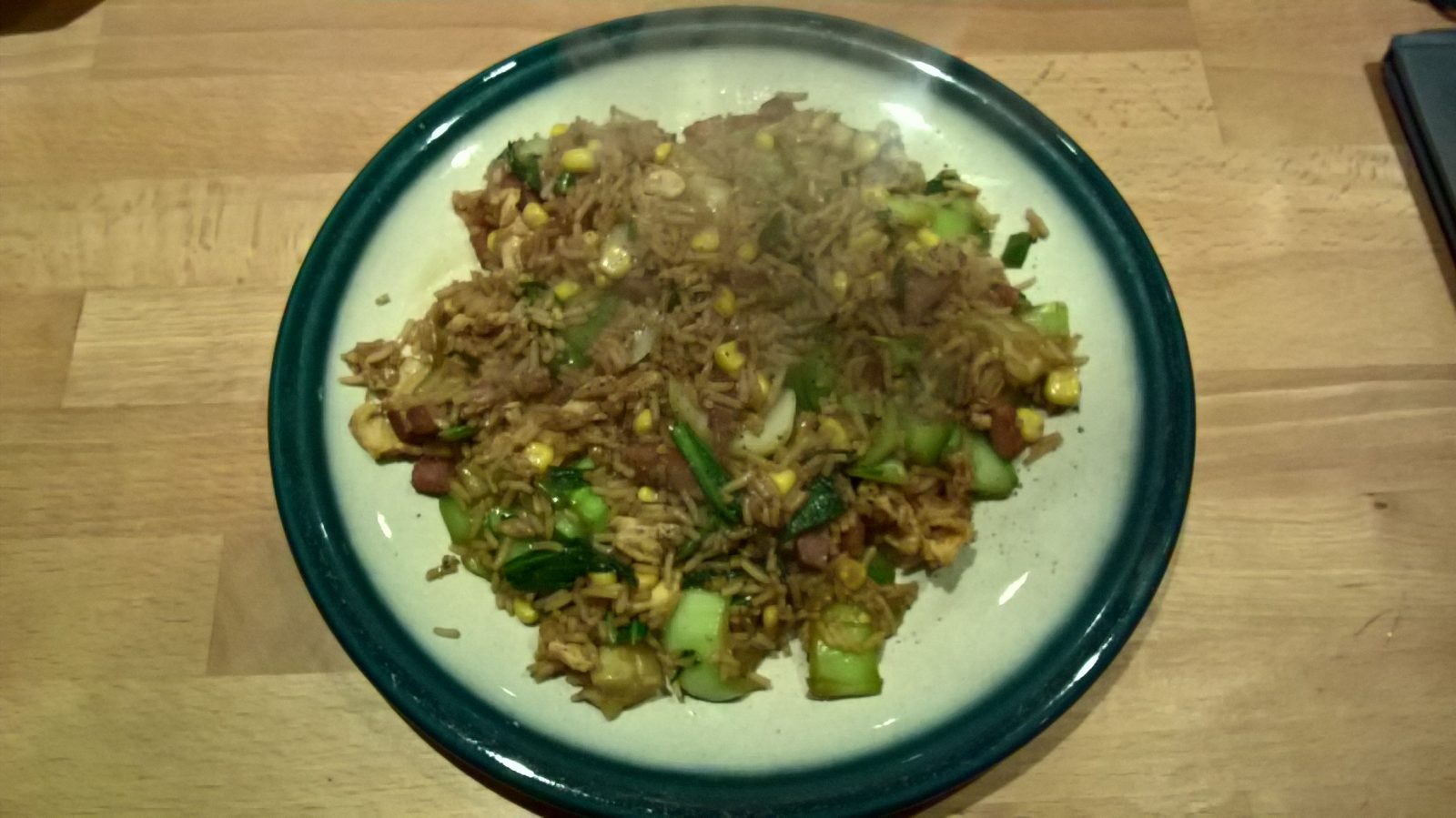
Frank conjured up this dish using the juicy pak choi in this week’s veg boxes, but it can be made with any combination of meat, vegetables or seafood.
Serves 2
Preparation time: 10 minutes (if you have left over cold, cooked rice)
Cooking time: 10 minutes
Ingredients
200 g rice, cooked and allowed to cool
1-2 heads pak choi
100 g pancetta or smoked bacon, shredded
6 spring onions, sliced
4 (or more) cloves garlic, finely chopped
1 red chilli, finely chopped
a handful frozen sweetcorn kernels
2 eggs, beaten with a drizzle of sesame oil
splash soy sauce
splash cooking oil
Method
Heat a wok or large frying pan until smoking hot. Add a splash of cooking oil, swirl to spread round the pan and add the eggs. Swirl the eggs until you have a thin omelette then remove to a warm plate and shred.
Add the pancetta or bacon to the pan and stir fry to release some fat, add the onions, garlic and chilli and continue stirring for a few seconds. Add the pak choi and sweetcorn and stir fry until the pak choi wilts.
Add the cold, cooked rice and continue stir frying over a high heat until the whole lot is piping hot. Stir in the shredded egg and a splash of soy sauce to taste and serve.


